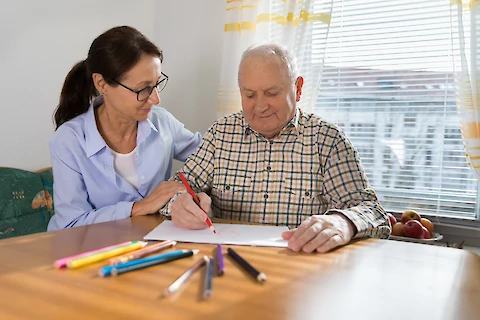Dementia-related behaviors
As dementia progresses, home caregivers can expect challenging behaviors to arise. Some of the more common behaviors that a caregiver may experience are:
● Wandering
● Verbal or physical aggression
● Anxiety
● Repetitive speech or action
● Fear
● Delusions
● Paranoia
● Inappropriate social interactions
Behaviors are one of the few ways a person with late-stage dementia can communicate their needs. If your loved one does engage in negative behaviors, redirection is a powerful technique that can help calm them down.
What is Redirection?
All behaviors are usually preceded by a trigger. People with dementia can't always reliably communicate what they want. They could be hungry, incontinent, or in pain and acting out as a means to communicate this to their caregiver. Redirection is a method that home caregivers can use to interrupt their loved one's negative mindset before it becomes dangerous. Redirection is a gentle way to draw their attention away from the source of their anxiety, re-centering it on something more positive and purposeful.
Redirection Techniques
When a person with dementia is in the midst of a dangerous behavior, a 24-hour caregiver can divert their attention and gently stop the behavior using a four-step method.
1. Understand the emotion behind the behavior
In order for your redirection efforts to be successful, you have to read the room. If behaviors are an attempt at communicating discomfort, whether that discomfort is real or a product of eroding neural connections, then you have to identify the underlying emotion before engaging in a redirection attempt.
2. Validate their feelings
It should be noted that although many behavioral triggers are imagined or the result of misinterpreted social cues, they feel very real to the person experiencing them. In order to effectively redirect someone in crisis, the home caregiver has to make them feel heard, establishing trust and rapport in the process.
3. Give them a new focal point
Once you've proven that you are there to help, you must give the person something new to focus on. This is the point in the process where you introduce some form of meaningful activity that you and the person can engage in together. Once you establish a new focal point, more often than not you'll see the behavior disappear.
4. Communicate a benefit
Sometimes providing a new focal point isn't enough. In order to provide good, consistent senior care, you have to communicate a benefit to them as well. This is especially effective in people who retain a higher level of memory and cognition. They might require that the redirection attempt be anchored to a reason or personal benefit.
Compassionate Care Techniques
For 24 hour caregivers, dealing with dementia can be an overwhelming task. But it doesn't have to be. Senior Helpers of Crown Point can help your loved one with dementia age comfortably in place using our GEMS program. Please contact us today to learn more.
